Illustration of a Gaussian surface around on plate of a charged capacitor to understand the displacement current appearing in Maxwell’s equations.
% Author: Izaak Neutelings (February 2020)
\documentclass[border=3pt,tikz]{standalone}
\usepackage{physics}
\usepackage{xcolor}
\usetikzlibrary{decorations.markings}
\tikzset{>=latex} % for LaTeX arrow head
\colorlet{Ecol}{orange!90!black}
\colorlet{Bcol}{violet!90}
\colorlet{Icol}{blue!70!black}
\colorlet{gausscol}{green!40!black}
\colorlet{gausscol2}{green!45!blue}
\tikzstyle{current}=[->,Icol,thick]
\colorlet{pluscol}{red!60!black}
\colorlet{minuscol}{blue!60!black}
\tikzstyle{anode}=[top color=red!20,bottom color=red!50,shading angle=20]
\tikzstyle{cathode}=[top color=blue!20,bottom color=blue!40,shading angle=20]
\tikzstyle{gauss surf}=[gausscol,top color=green!2,bottom color=green!80!black!70,shading angle=5,fill opacity=0.4]
\tikzstyle{metal}=[top color=black!15,bottom color=black!25,middle color=black!20,shading angle=10]
\tikzstyle{mydashes}=[dash pattern=on 1 off 1]
\tikzset{
EFieldLine/.style={thick,Ecol,line cap=round,decoration={markings,
mark=at position #1 with {\arrow{latex}}},
postaction={decorate}},
BFieldLine/.style={thick,Bcol,postaction={decorate},decoration={markings,
mark=at position #1 with {\arrow{latex}},
mark=at position #1+0.5 with {\arrow{latex}}}},
EFieldLine/.default=0.5,
BFieldLine/.default=0.4}
\usetikzlibrary{3d}
\begin{document}
% CAPACITOR 3D - displacement current derivation
\begin{tikzpicture}[xscale=0.42]
\def\RC{1.2} % radius capacitor
\def\RW{0.1*\RC} % radius wire
\def\RA{1.6} % radius ampere loop
\def\D{2.6*\RA} % distance between plates
\def\T{0.4} % plate thickness
\def\L{2*\RA} % wire length
\def\NE{5} % number of electric field lines
% CATHODE WIRE
\draw[metal]
(\D+\T,\RW) --++ (\L,0) arc (90:-90:\RW) --++ (-\L,0);
% CATHODE
\draw[cathode,top color=blue!90!black!30,bottom color=blue!80!black!50]
(\D,\RC) --++ (\T,0) arc (90:-90:\RC) --++ (-\T,0);
\draw[cathode] (\D,0) circle (\RC);
% ELECTRIC FIELD
\foreach \i [evaluate={\y=-\RC+(\i-0.5)*(2*\RC)/\NE);}] in {1,...,\NE}{
\draw[EFieldLine={0.68},very thick] (0,\y) --++ (\D,0);
}
\node[Ecol,above] at (0.59*\D,0.9*\RC) {$\vb{E}$};
% ANODE
\draw[anode,top color=red!90!black!20,bottom color=red!80!black!50]
(-\T,\RC) --++ (\T,0) arc (90:-90:\RC) --++ (-\T,0);
\draw[anode] (-\T,0) circle (\RC);
% ANODE WIRE LEFT
\draw[metal]
(-\T,\RW) arc (90:-90:\RW) --++ (-\L,0) arc (-90:90:\RW) -- cycle;
% SURFACE
\draw[gauss surf,very thin,fill opacity=0.3,gausscol2,
top color=gausscol2!20,bottom color=gausscol2!80!black!70]
%(-\T-\L,\RA) arc (90:-90:{1.2*(\T+\L+\RA)} and {\RA}) arc (-90:90:\RA);
(-\T-\L,1.006*\RA) to[out=-4,in=90,looseness=0.7] (\T+\RA,0) to[out=-90,in=4,looseness=0.7] (-\T-\L,-1.006*\RA) arc (-90:90:1.006*\RA);
\draw[gauss surf,thick]
(-\T-\L,0) circle (\RA);
\node[gausscol] at (-\T-\L-0.7*\RA,\RA) {$C$};
\node[gausscol!70] at (-\T-\L-0.6*\RA,-1.05*\RA) {$S_1$};
\node[gausscol2!70] at (-0.5*\RA,-1.05*\RA) {$S_2$};
\node[pluscol] at (0.7*\RC,-1.15*\RC) {$+Q$};
\node[minuscol] at (\D+0.7*\RC,-1.15*\RC) {$-Q$};
% ANODE WIRE RIGHT
\draw[metal]
(-\T-\L,\RW) arc (90:-90:\RW) --++ (-\L,0) arc (-90:90:\RW) -- cycle;
\draw[mydashes,black!80,very thin]
(-\T-\L,0.94*\RW) arc (90:270:0.94*\RW);
\draw[metal]
(-\T-2*\L,0) circle (\RW);
% CURRENT
\draw[current] (-\T-1.95*\L,1.7*\RW) --++ (0.7*\L,0) node[pos=0.4,above=-1] {$I$};
\draw[current] (\D+\RC+0.15*\L,1.7*\RW) --++ (0.7*\L,0) node[pos=0.4,above=-1] {$I$};
\end{tikzpicture}
% CAPACITOR 3D - displacement current derivation (cylinder)
\begin{tikzpicture}[xscale=0.3]
\def\RC{1.2} % radius capacitor
\def\RW{0.1*\RC} % radius wire
\def\RA{1.3} % radius ampere loop
\def\D{3.5*\RA} % distance between plates
\def\T{0.4} % plate thickness
\def\L{2.6*\RA} % wire length
\def\NE{5} % number of electric field lines
\def\Sx{0.3*\D} % x position S2
% CATHODE WIRE
\draw[metal]
(\D+\T,\RW) --++ (\L,0) arc (90:-90:\RW) --++ (-\L,0);
% CATHODE
\draw[cathode,top color=blue!90!black!30,bottom color=blue!80!black!50]
(\D,\RC) --++ (\T,0) arc (90:-90:\RC) --++ (-\T,0);
\draw[cathode] (\D,0) circle (\RC);
% ELECTRIC FIELD
\foreach \i [evaluate={\y=-\RC+(\i-0.5)*(2*\RC)/\NE);}] in {1,...,\NE}{
\draw[EFieldLine={0.76},very thick] (0,\y) --++ (\D,0);
}
\node[Ecol,above] at (0.75*\D,0.88*\RC) {$\vb{E}$};
% SURFACE S2
\draw[gauss surf,thick,fill opacity=0.2,gausscol2,
top color=gausscol2!20,bottom color=gausscol2!80!black!70]
(\Sx,0) circle (\RA);
\foreach \i [evaluate={\y=-\RC+(\i-0.5)*(2*\RC)/\NE);}] in {1,...,\NE}{
\draw[Ecol,very thick,line cap=round] (0,\y) --++ (\Sx,0);
}
% ANODE
\draw[anode,top color=red!90!black!20,bottom color=red!80!black!50]
(-\T,\RC) --++ (\T,0) arc (90:-90:\RC) --++ (-\T,0);
\draw[anode] (-\T,0) circle (\RC);
% ANODE WIRE LEFT
\draw[metal]
(-\T,\RW) arc (90:-90:\RW) --++ (-\L,0) arc (-90:90:\RW) -- cycle;
% SURFACE S1
\draw[gauss surf,draw=none,fill opacity=0.25]
(\Sx-0.01,\RA) arc(90:-90:\RA) -- (-\T-\L,-\RA) arc(-90:90:\RA);
\draw[gausscol,thin]
(\Sx,\RA+0.007) -- (-\T-\L,\RA+0.007)
(\Sx,-\RA-0.007) -- (-\T-\L,-\RA-0.007);
\draw[gauss surf,thick]
(-\T-\L,0) circle (\RA);
\node[gausscol,left=0] at (-\T-\L,1.10*\RA) {$C_1$};
\node[gausscol2,right=-7] at (\Sx,1.14*\RA) {$C_2$};
%\node[gausscol!70] at (-\T-\L-0.6*\RA,-1.05*\RA) {$S_1$};
%\node[gausscol2!70] at (\Sx+0.2*\D,-1.05*\RA) {$S_2$};
\node[pluscol] at (-0.1*\D,-1.25*\RC) {$+Q$};
\node[minuscol] at (1.0*\D,-1.20*\RC) {$-Q$};
% ANODE WIRE RIGHT
\draw[metal]
(-\T-\L,\RW) arc (90:-90:\RW) --++ (-\L,0) arc (-90:90:\RW) -- cycle;
\draw[mydashes,black!80,very thin]
(-\T-\L,0.94*\RW) arc (90:270:0.94*\RW);
\draw[metal]
(-\T-2*\L,0) circle (\RW);
% CURRENT
\draw[current] (-\T-1.95*\L,1.7*\RW) --++ (0.8*\L,0) node[pos=0.4,above=-1] {$I$};
\draw[current] (\D+\RC+0.15*\L,1.7*\RW) --++ (0.8*\L,0) node[pos=0.4,above=-1] {$I$};
\end{tikzpicture}
% CAPACITOR 3D - magnetic fields
\begin{tikzpicture}[xscale=0.42]
\def\RC{1.2} % radius capacitor
\def\RW{0.1*\RC} % radius wire
\def\RA{1.6} % radius ampere loop
\def\D{2.6*\RA} % distance between plates
\def\T{0.4} % plate thickness
\def\L{2*\RA} % wire length
\def\NE{4} % number of electric field lines
\def\NB{2} % number of magnetic field lines
% MAGNETIC FIELD LINES back
\foreach \x in {-0.5*\D,0.5*\D,1.6*\D}{
\foreach \i [evaluate={\r=\i*\RA/\NB);}] in {1,...,\NB}{
\draw[BFieldLine={0.35}] (\x,0) circle (\r);
}
}
% CATHODE WIRE
\draw[metal]
(\D+\T,\RW) --++ (\L,0) arc (90:-90:\RW) --++ (-\L,0);
% CATHODE
\draw[cathode,top color=blue!90!black!30,bottom color=blue!80!black!50]
(\D,\RC) --++ (\T,0) arc (90:-90:\RC) --++ (-\T,0);
\draw[cathode] (\D,0) circle (\RC);
% ELECTRIC FIELD
\foreach \i [evaluate={\y=-\RC+(\i-0.5)*(2*\RC)/\NE);}] in {1,...,\NE}{
\draw[EFieldLine={0.6},very thick] (0,\y) --++ (\D,0);
}
\node[Ecol,above] at (0.52*\D,0.78*\RC) {$\vb{E}$};
\node[Bcol,above] at (0.20*\D,0.80*\RA) {$\vb{B}$};
% ANODE
\draw[anode,top color=red!90!black!20,bottom color=red!80!black!50]
(-\T,\RC) --++ (\T,0) arc(90:-90:\RC) --++ (-\T,0);
\draw[anode] (-\T,0) circle (\RC);
% ANODE WIRE LEFT
\draw[metal]
(-\T,\RW) arc (90:-90:\RW) --++ (-\L,0) arc (-90:90:\RW) -- cycle;
\draw[metal]
(-\T-\L,0) circle (\RW);
% SURFACE
\node[pluscol] at (-0.1*\D,-1.2*\RC) {$+Q$};
\node[minuscol] at (1.0*\D,-1.2*\RC) {$-Q$};
% CURRENT
\draw[current]
(-\T-0.95*\L,1.7*\RW) --++ (0.6*\L,0) node[pos=0.6,above=-1] {$I$};
\draw[current]
(\D+\RC+0.24*\L,1.7*\RW) --++ (0.6*\L,0) node[pos=0.35,above=-1] {$I$};
% MAGNETIC FIELD LINES front
\foreach \x in {-0.5*\D,0.5*\D,1.6*\D}{
\foreach \i [evaluate={\r=\i*\RA/\NB);}] in {1,...,\NB}{
\draw[Bcol,thick] (\x,\r) arc(90:-90:\r);
}
}
\end{tikzpicture}
\end{document}
Click to download: displacement_current.tex • displacement_current.pdf
Open in Overleaf: displacement_current.tex


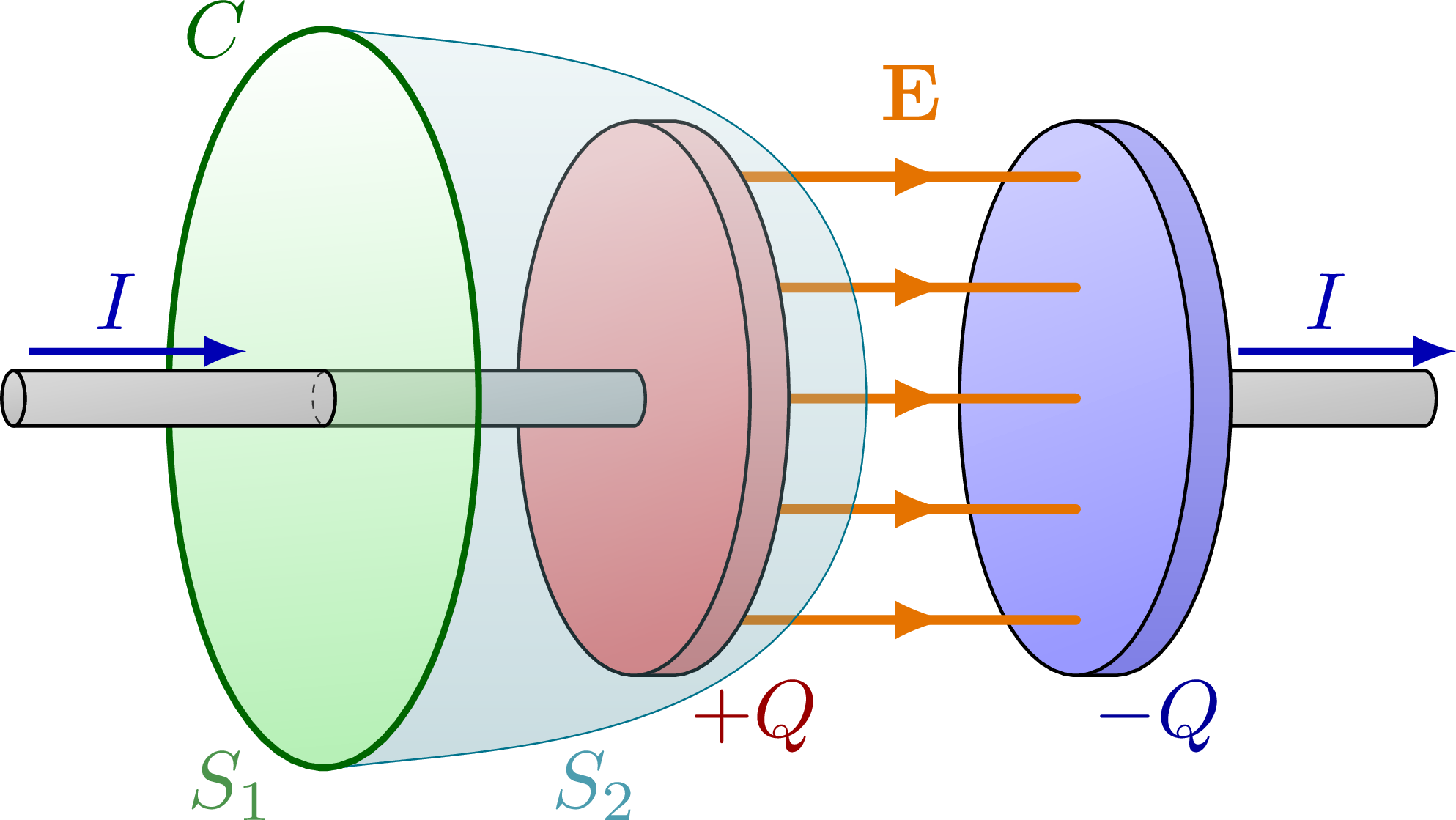
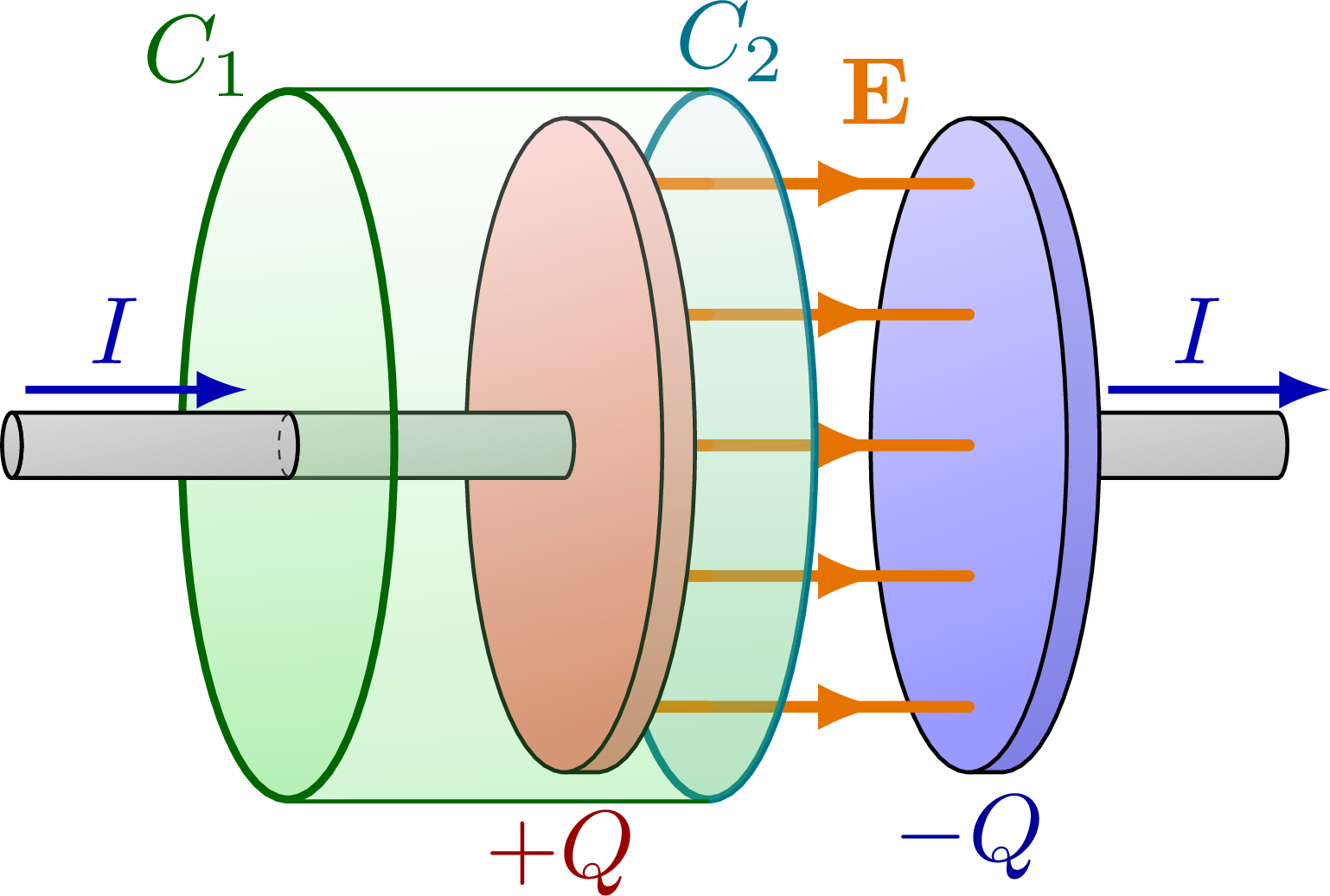
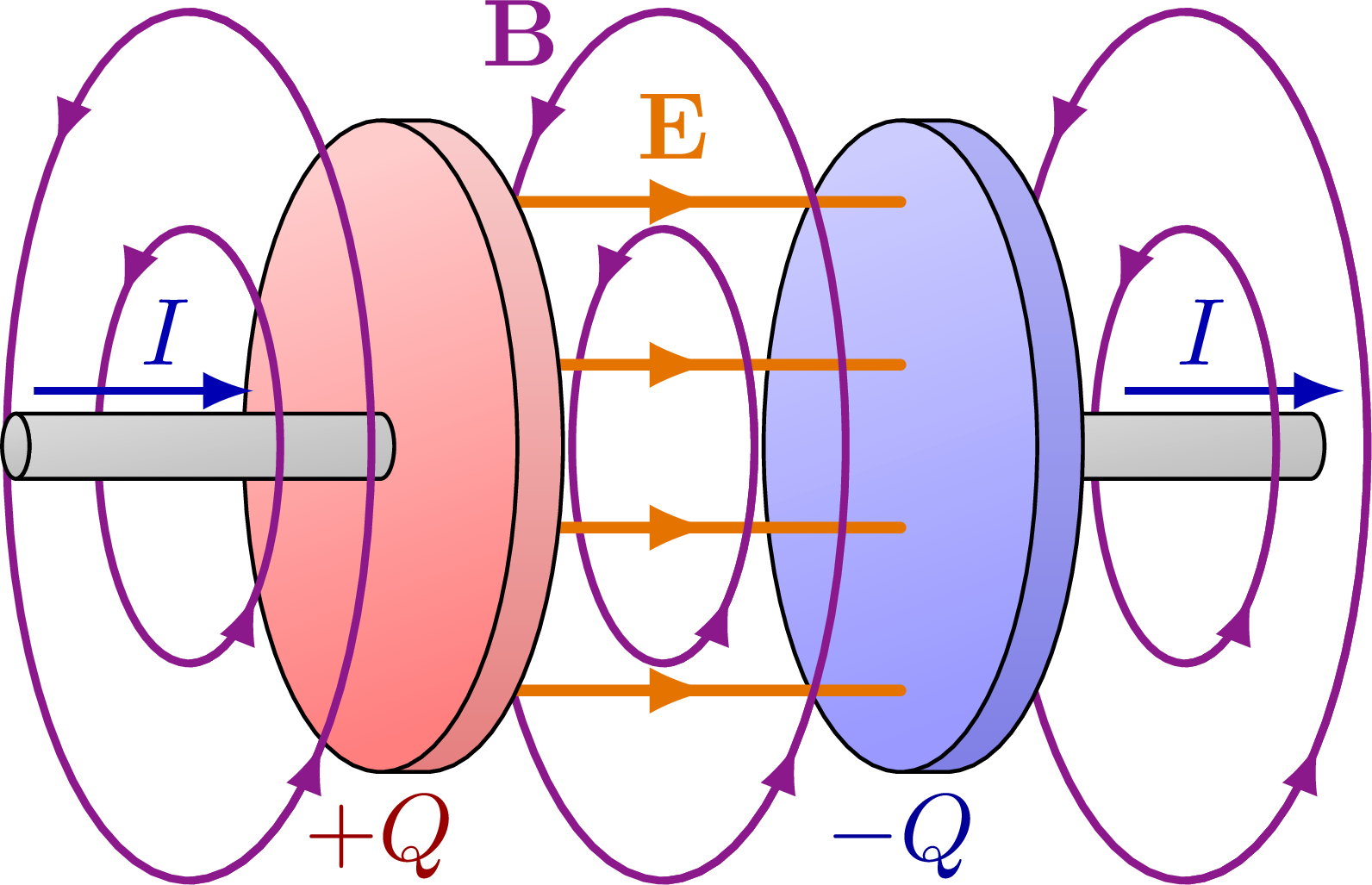
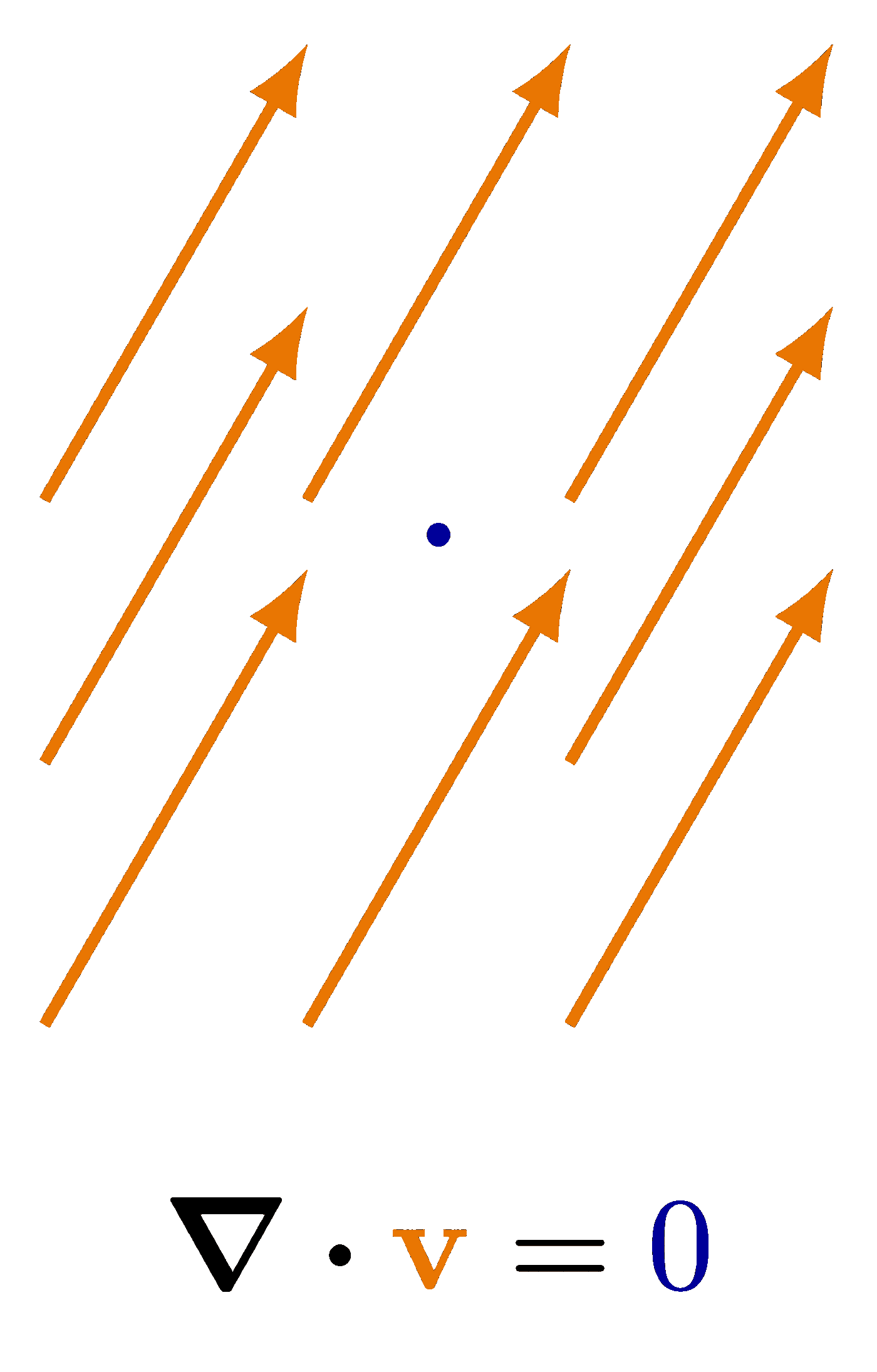
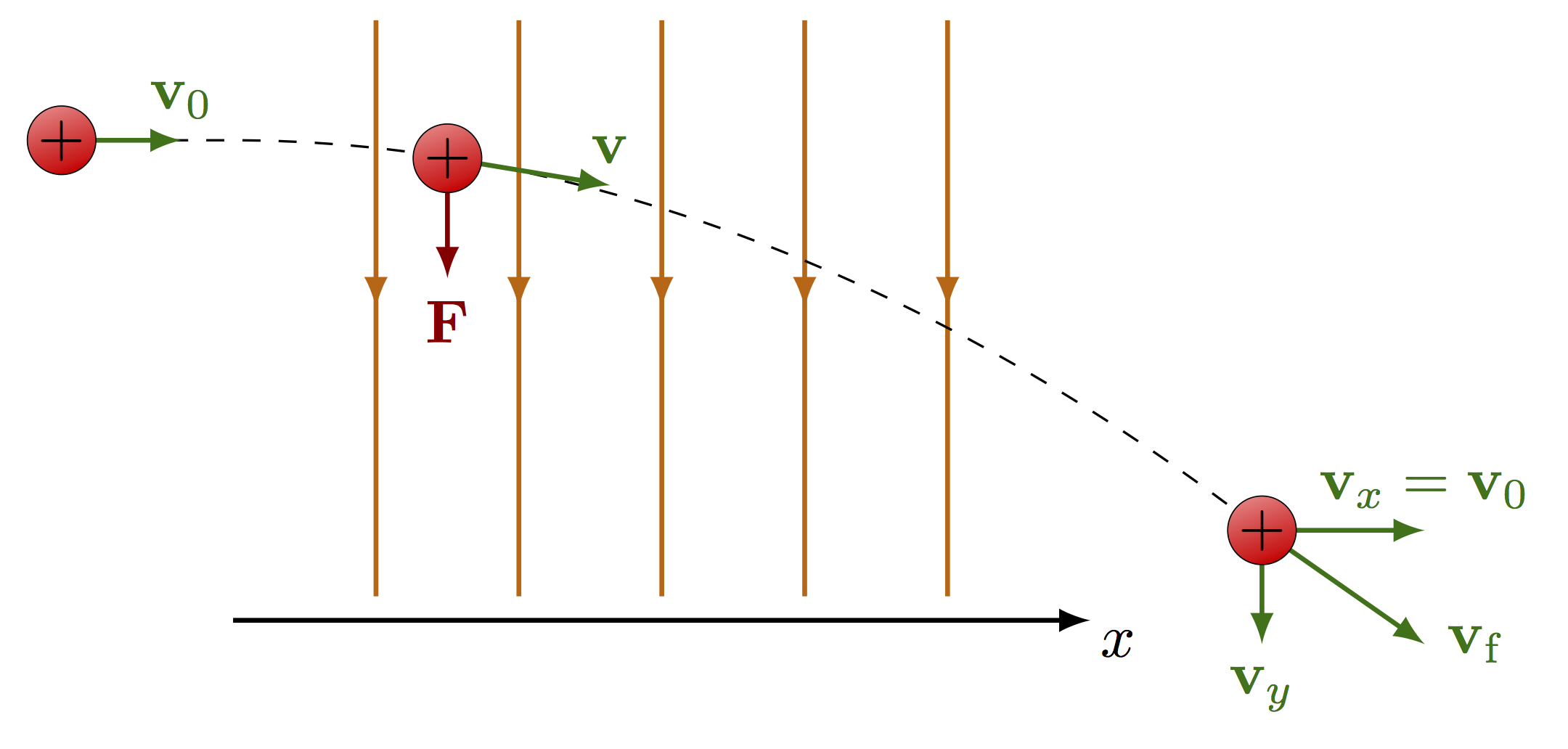
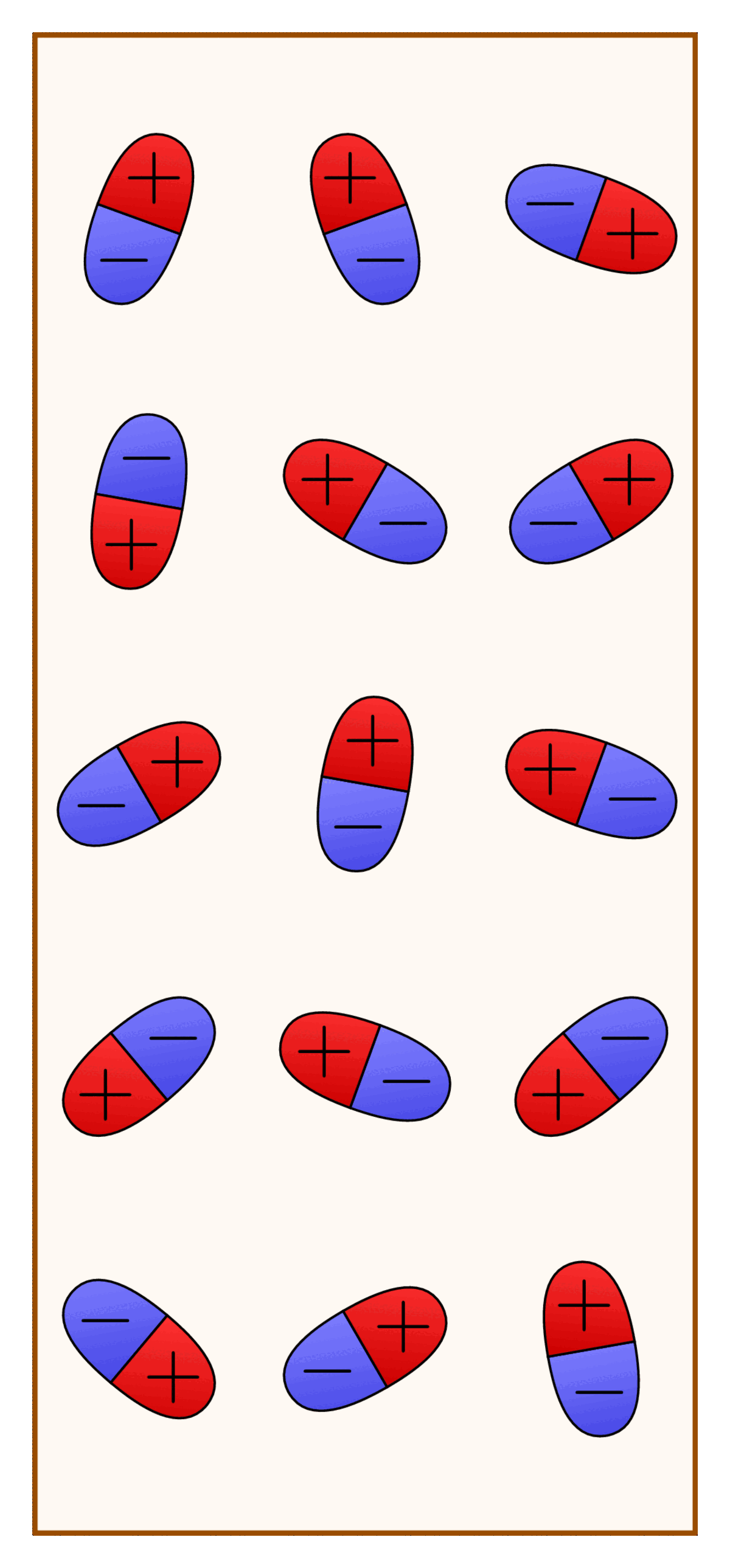
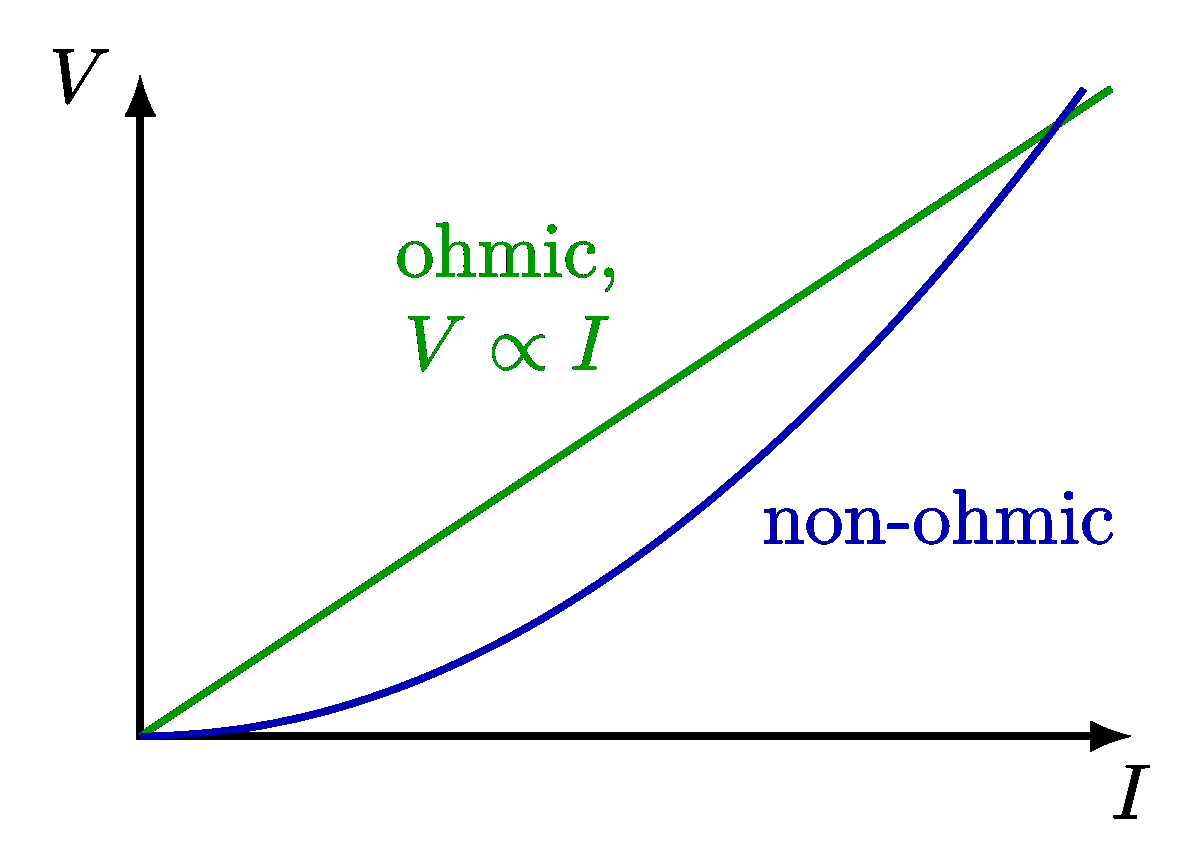
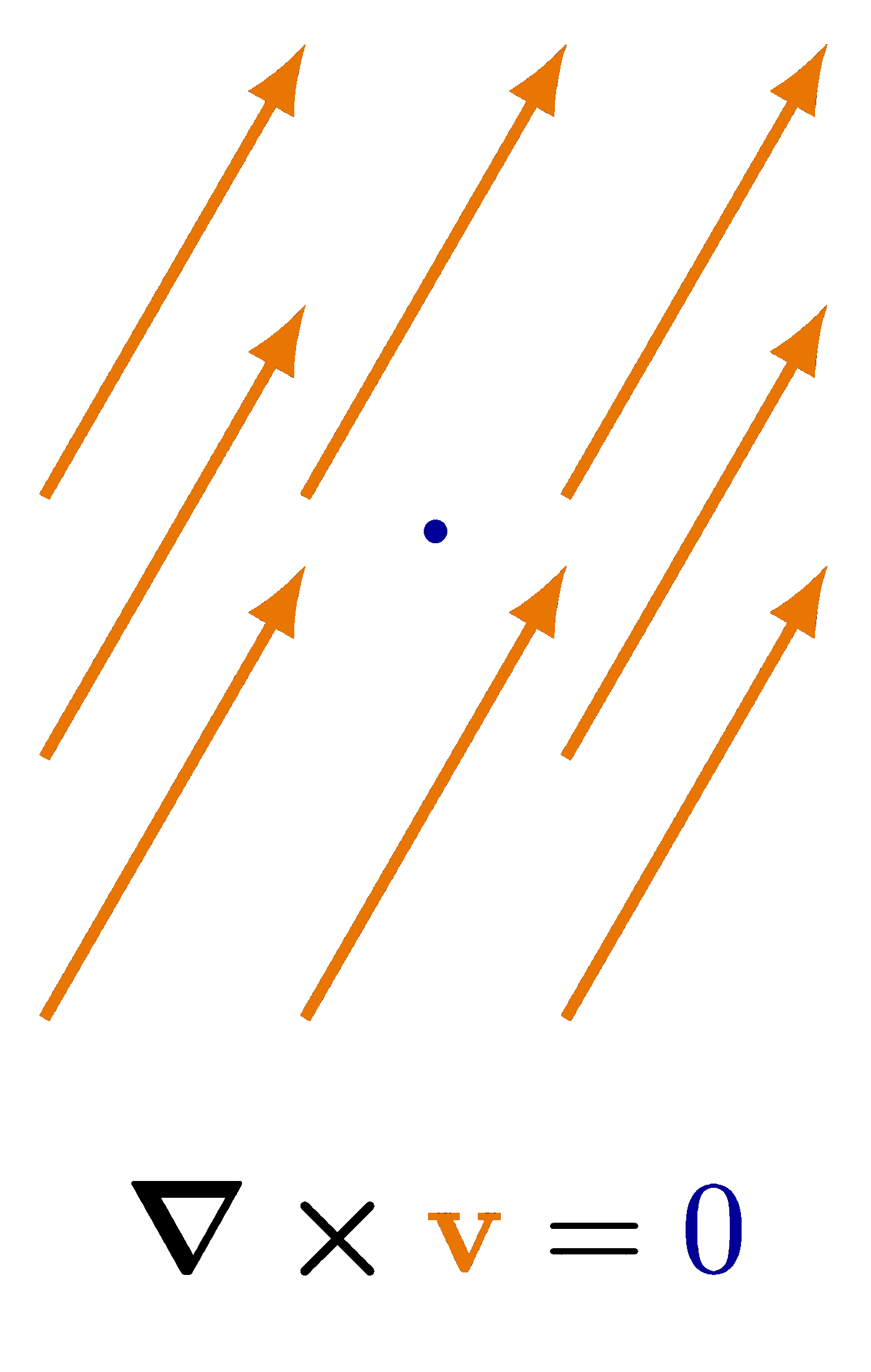
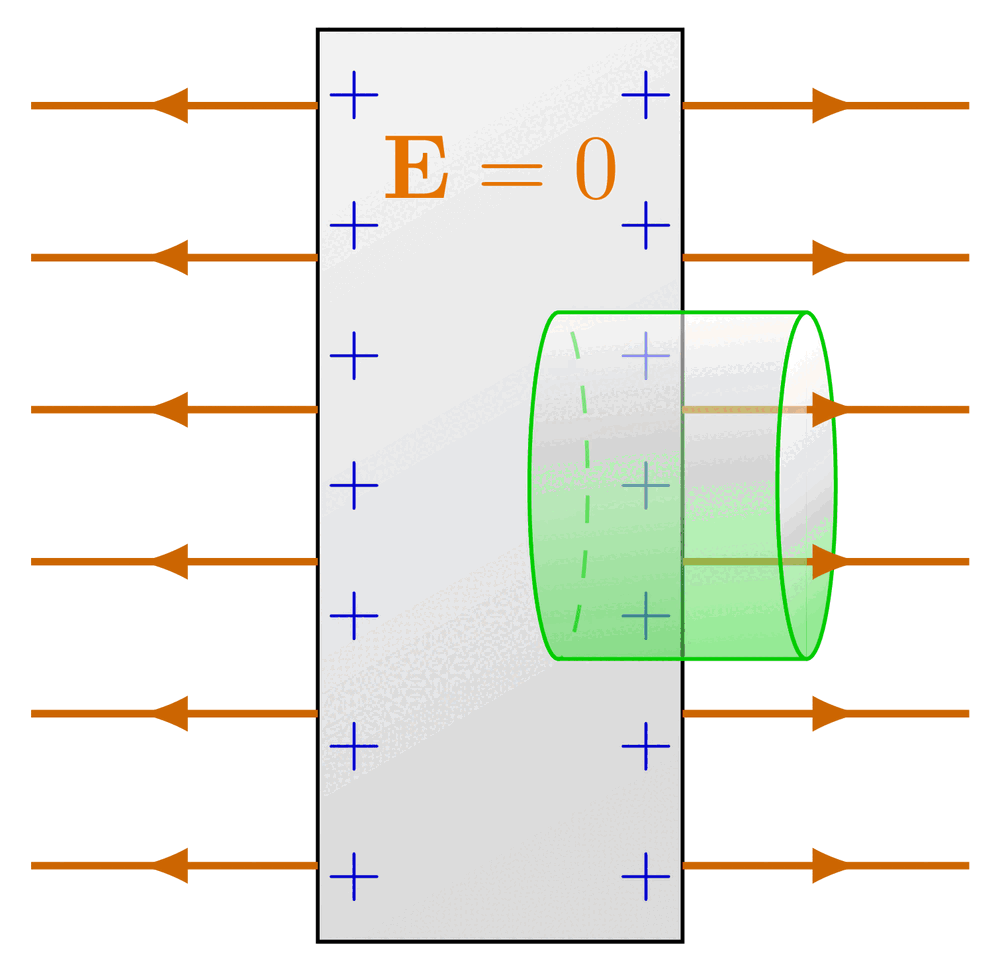
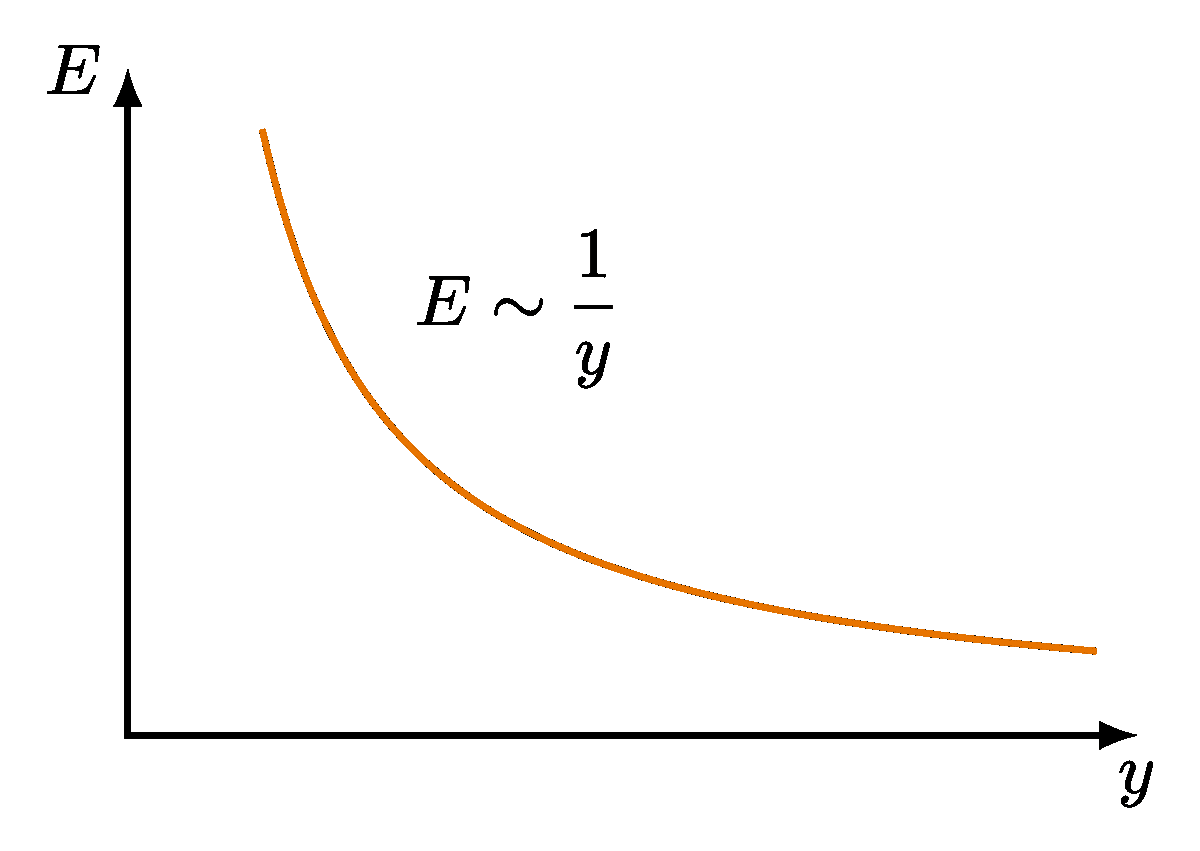
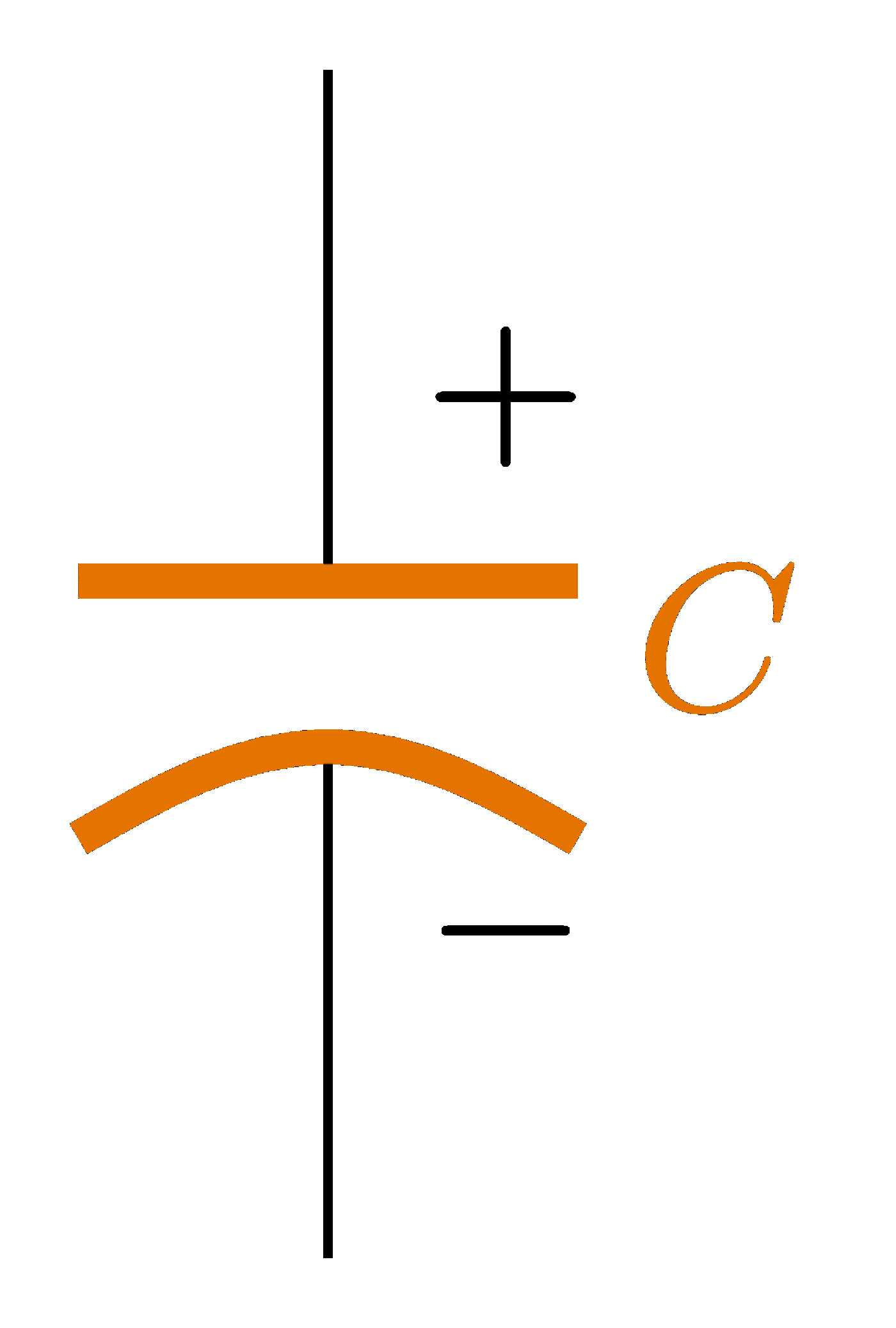
Loved it